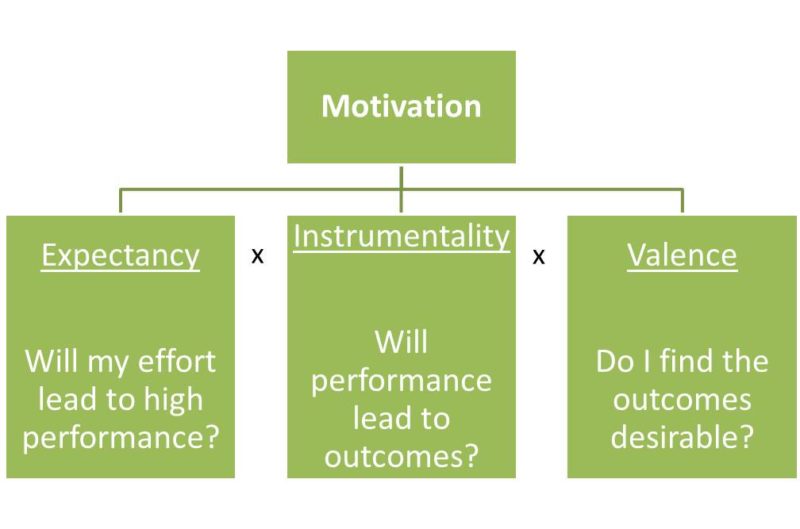Vroom’s expectancy theory was originally developed by Victor H. Vroom, a Canadian psychologist, in 1964. Attacking Herzberg’s two-factor theory, Vroom offered an expectancy approach to the understanding of motivation. According to him, a person’s motivation towards an action at any time would be determined by an individual’s perception that a certain type of action would lead to a specific outcome and his personal preference for this outcome. Vroom’s expectancy theory consisted of two related models – the valence model and the force model. The valence model attempts to capture the perceived attractiveness, or valence, of an outcome by aggregating the attractiveness of all associated resultant outcomes. The force model of expectancy theory attempts to capture motivational force to act by associating the expectancy of resultant outcomes and their individual valences. These two models gave Vroom the opening to build his expectancy theory to the level that it is today most Continue reading
Management Theories
3 Common Types of Organizational Structure
Organizational structure is the internal, formal framework of a business that shows the way in which management is linked together and how the authority is transmitted. It is basically a framework used to describe the hierarchy in an organisation. Every business needs to have their own organizational structure as it helps in identifying the job at each level of an individual followed by its functions and it also assists in obtaining their own goals for development. There is a need for every type of organisation to have their own structure specially when it comes to large enterprises as it becomes difficult activities of the various departments and functions. A business will opt for an organisation structure which is best suited to them and the way they would like to be working, and the chart they create will reflect this. A flat organisation is one that has eliminated most or all Continue reading
Six Elements of Organizational Design
Organizational design is a process of developing and changing the organization’s structure by its managers. It is a chart containing the reporting structure i.e. who reports to whom. Organizational structure is thus a framework on which an organization is patterned for coordinating and carrying out organizational tasks. Organizational design involves decisions about the following six elements: 1. Work Specialization: Work specialization describes to which the overall task of the organization is broken down and divided into smaller component parts. For example, one person would paint a wall and another person fixes a door. So by breaking jobs up into small tasks, it could be performed over and over every 10 seconds while using employees who had relatively limited skills. The main thought of this process is that the entire job is not done by an individual and it is broken down into steps, and a different person completes each step. Continue reading
Line and Staff Organization – Meaning, Features, and Advantages
A line and staff organization is a mixture of the line as well as staff organization. Line organization points out direct vertical relationships, i.e., superior-subordinate relationship connecting the positions at each level. It forms a chain of command or hierarchy of authority on scalar principles. A line relationship is simply known as a relationship of authority between the superior and subordinates in a hierarchical arrangement. The direct line superior has control over his immediate subordinates. In this case, authority flows downward and accountability goes upward in a straight line. The work also flows in a direct line. The line offices are responsible for accomplishing basic objectives, so that they can issue orders and implement plans and policies with the help of their subordinates. They are authorized to maintain discipline. The line organization maintains direct communication from the higher to lower levels and vice versa. If it is useful for Continue reading
Difference Between Tall and Flat Organizational Structure
The concept of organization is born when two or more people work together in order to achieve a common goal. Purpose of an organisation is to create responsibilities and positions by which an organisation can carry out the work. Organisation may be formed in different sizes. All people working in the same organisation have their own functions, attitudes and techniques to apply for achieving their common goal. In order to manage and control the resources, an organisation needs to be structured. Organization structure is formal system that makes the organisation to run smoothly and helps to focus the common goals and objectives. It gives a clear idea about the chain of command that need to be prioritized when a problem arise. It also defines what people are responsible in the organisation for different reasons. A solid structure provides the framework to deliver on business strategy. The structure of an organisation Continue reading
Organization Structure and Management Control
Four different types of organization structures have been identified for managing the tasks of the organization. These are (i) a centralized functional structure, (ii) a decentralized divisional structure, (ii) a hybrid (matrix) structure, and (iv) network/coupling structure. An important aspect in the design of management control systems is that it should be linked with responsibility centers. Because of this intimate linkage between the control system and the organization structure, it becomes important to know about key control considerations in the choice of an organization structure. Important parameters on the basis of which choice of the structure can be decided are (i) efficiency and effectiveness, (ii) economies of scale, (iii) problems of coordination, (iv) assignment of profit responsibility, (v) conflict and cooperation. Since efficiency is related to level of activity, as the level of activity increases efficiency also increases. Size permits the division of labor and specialization within Continue reading


